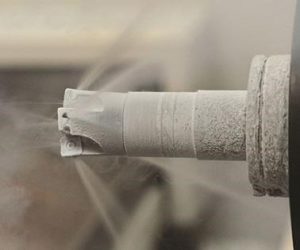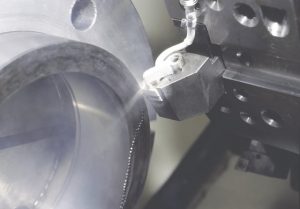Liquid nitrogen insert cooling extends insert life and allows greater use of low-cost ceramic inserts for hard turning cryogenic machining operations.
Cubic boron nitride (CBN) and polycrystalline cubic boron nitride (PCBN) inserts have traditionally been the tools of choice for hard turning applications. However, many shops contemplating hard turning are turned off by their high price. A new extreme-temperature coolant method has been developed to offer longer insert life, faster cutting rates and more affordable hard turning insert options.

The Icefly cryogenic machining coolant system from Air Products (Lehigh Valley, Pennsylvania) delivers a jet of –320°F liquid nitrogen directly to the insert during turning operations. The liquid nitrogen raises insert hardness, which significantly reduces the thermal softening effect that an insert may experience as a result of hard turning inherent high cutting temperatures. The steep temperature gradient between the chip/tool interface and insert body also helps remove heat from the cutting zone. In addition, the significant cooling maintains insert edge integrity to prevent “smearing” a part’s hot, compressed surface layer, thus providing a quality surface finish.
Unlike CBN and PCBN, ceramic inserts tend to wear unevenly and are prone to fracturing when hard turning dry or with water- or oil-based coolants. Increased fracture toughness resulting from low-temperature liquid nitrogen cooling provides more predictable, gradual flank wear for ceramic inserts, as well as increased cutting speeds up to 200 percent, according to the company. This predictable flank wear also allows alumina ceramic inserts to be used in critical finishing operations, where PCBN inserts are used almost exclusively today.

Icefly can be a stand-alone or supplemental cooling system. It is retrofittable to a variety of machines and is now available as an option on Quest lathes from Hardinge, Inc. (Elmira, New York). The liquid nitrogen may be stored in a small, dedicated cylinder near a machine, or in a supply tank that would serve multiple machines. Programming is similar to a traditional coolant delivery system. A flexible liquid nitrogen line attaches to a lathe’s turret via a rotational coupling. This line feeds a delivery nozzle clamped to the tool, which directs the liquid nitrogen to the insert tip.
The system works with hardened steels, hard composites and powder metal parts. Because the inert nitrogen vaporizes after contact with the insert, it doesn’t leave behind residue. This is particularly helpful for porous powder metal parts, which often require subsequent part cleaning operations to remove coolant residue.
